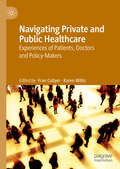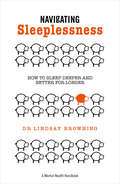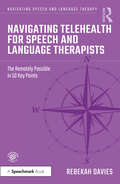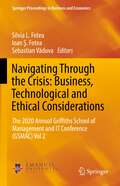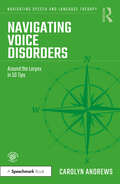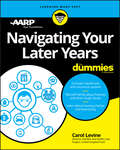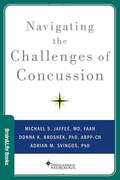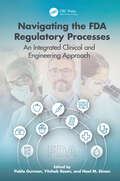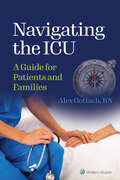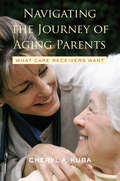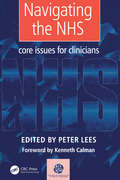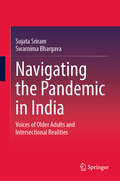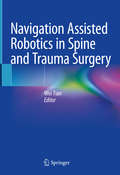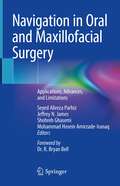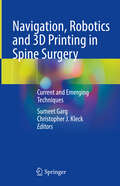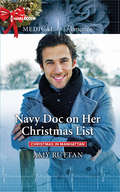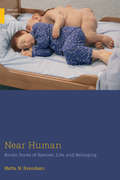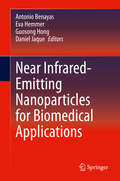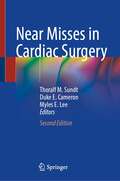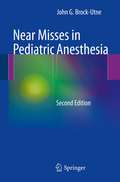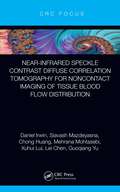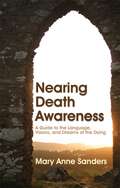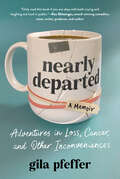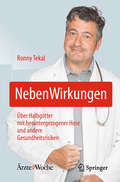- Table View
- List View
Navigating Private and Public Healthcare: Experiences of Patients, Doctors and Policy-Makers
by Fran Collyer Karen WillisThis edited collection focuses on the global growth of privatisation and private sector medicine in both developed and lesser developed countries, and the impact of this on patients, health workers, managers and policy-makers. Drawing upon sociological theories, concepts and insights, as well as experts from several countries with extensive experience in researching the field either nationally or internationally, the collection offers a unique perspective on healthcare services and healthcare systems: a view from those trying to access healthcare services, working inside health systems, or responsible for managing and organising services. Collectively, the chapters contribute an international perspective on the navigation of healthcare systems, and addresses the growing salience of ‘choice’ between public and private medicine in a variety of different national systems and contexts.
Navigating Sleeplessness: How to Sleep Deeper and Better for Longer (A Mental Health Handbook)
by Lindsay BrowningWe are experiencing a sleeplessness epidemic, but we can all take steps to improve the quality of our sleep. We all sleep differently. The key to sleeping well is to develop good habits that work for you. In this book you will learn to understand your patterns and discover what works, so that you can build and maintain a healthy personal sleep plan. This book offers actionable strategies and step-by-step solutions to develop better sleep, using self-care and self-compassion. You will discover how to:•Understand the difference between 'good' and 'bad' sleep.•Cope better with temporary sleeplessness.•Begin to unlearn unhelpful sleeping habits. •Challenge your misconceptions about how well, or badly, you sleep.•Practice tailored self-care that’s likely to lead to improved sleep.
Navigating Telehealth for Speech and Language Therapists: The Remotely Possible in 50 Key Points (Navigating Speech and Language Therapy)
by Rebekah DaviesThere is so much to consider in any clinical consultation: identifying the individual is the one you expected, who is with the individual, which therapy intervention, resources, signposting, referrals, being cued in to responses for contextual information, evaluation and outcomes, planning next steps … and this is all before you throw ‘virtual’ in the mix! This clinical companion presents 50 transferable, adaptable, practical and accessible chapters for speech and language therapists and others working via remote consultations. Divided into four sections, the book covers: The remote practitioner. The remote rules. Creating a digital tool kit. A remotely possible future. Aimed at students encountering their first remote consultations, newly qualified clinicians with limited practical experience of virtual clinics through to clinicians who are experienced in their own specialities but now need to transfer those skills to remote ways of delivery, this concise text will provide confidence and guidance for the reader. It will also prove useful to clinicians beyond speech and language as many of the skills and practical advice and guidance are applicable in specialities across a range of settings, both public and private, healthcare and education.
Navigating Through the Crisis: The 2020 Annual Griffiths School of Management and IT Conference (GSMAC) Vol 2 (Springer Proceedings in Business and Economics)
by Sebastian Văduva Ioan Ş. Fotea Silvia L. FoteaThis proceedings volume provides a multifaceted perspective on the unprecedented crises generated by the global COVID-19 pandemic, and its ramifications for individuals, businesses, organizations, governments and systems in developing countries. Featuring selected papers from the 2020 Annual Griffiths School of Management and IT Conference (GSMAC), held in Oradea, Romania, this volume focuses on business, technological and ethical considerations in the process of navigating through a global crisis. It analyzes the effectiveness of different measures taken at individual, organizational and country level and outlines potential scenarios and solutions for the new post-crisis reality. Finally, the book provides diagnosis and recommendations for managerial practice in various industries impacted.
Navigating Voice Disorders: Around the Larynx in 50 Tips (Navigating Speech and Language Therapy)
by Carolyn AndrewsThis book comprises 50 tips for speech and language therapy practitioners who are new to, or less experienced in, working with adult voice disorders. It considers the full clinical pathway from assessment to management and on through to discharge. Packed with easily accessible, practical hints about therapy and useful self-development activities for the reader, sections cover: • Reflecting on the normal voice • ‘Doing’ therapy • Assessment • Management • Specific diagnoses • Professional voice users • Professional liason • Learning from clients The resource concludes with a handy appendix providing further reading and useful resources. Presenting diagnosis-specific and client group-specific tips alongside widely applicable guidance, this is a go-to book for accessible and practical support for voice newbies.
Navigating Your Later Years For Dummies
by Levine AarpLong-Term Care: Planning for Finance, Medical, and Living Expenses We’re living exciting bonus years—decades that our parents and grandparents didn’t have. But how to navigate this complex terrain? Questions abound around long-term care planning: Where to live? How to get the best medical care? What to do about advance directives, wills and trusts, and estate planning? And how to pay for it all after you retire? Getting accurate information and answers wasn’t easy. Until now. AARP's Navigating Your Later Years For Dummies helps you and your family understand the growing range of opportunities. Even more importantly, it helps you chart the next steps to live the life you choose, as independently as you choose, no matter your specific circumstances and needs. This book: Covers home modifications so that you can stay at home safely for as long as you like Lays out the opportunities and costs associated with independent living, assisted living and other options Gives you a range of driving and transportation alternatives Helps you navigate the healthcare system, Medicare, and Medicaid Sorts out the various sources of care at home Reviews the legal documents you should prepare and update Helps you determine whether you need long-term care insurance Gives you guidance on talking with your family about sensitive issues, including your wishes as you age With this new comprehensive book, you’ll get the credible information and resources you need to face the challenges facing us as we live the life we choose. Here, finally, is a roadmap for you and your family to best understand, and plan ahead.
Navigating the Challenges of Concussion (Brain and Life Books)
by Michael S. Jaffee Donna K. Broshek Adrian M. SvingosConcussion is one of the most common neurological conditions, with many people having experienced at least one concussion within a lifetime. Concussion has been the focus of great media attention which has brought awareness to this important health issue. While most have heard about athletes and concussions, these injuries can occur at any age and can have many causes such as car accidents and falls. <p><p> In Navigating the Challenges of Concussion, expert clinicians and researchers in the fields of neurology and neuropsychology teamed together to provide up-to-date and evidence-based information for patients and families affected by concussion or those at increased risk of sustaining concussions. Topics covered include how concussion is different from other forms of brain injury, what to expect after a concussion, and what to do if symptoms are persisting. The authors explore extensively the common misconceptions around the treatment of concussion, and instead offer evidence-based guidance to follow instead. Special considerations for children and students, athletes, employees, military personnel, and older adults are discussed. Patient stories are included throughout which highlight some of the experiences that patients with concussion may face and may relate to their own concussion journey.
Navigating the FDA Regulatory Processes: An Integrated Clinical and Engineering Approach
by Pablo Gurman, Yitzhak Rosen, and Noel M. ElmanThis book provides a unique knowledge source of the FDA’s regulatory processes to anyone interested in the development and approval of biomedical products.Navigating the FDA Regulatory Processes will be of particular importance for those innovating in biomedical devices, pharmacological therapies, and combination products, who are interested in considering regulatory affairs early on in product development. The authors offer a comprehensive exploration of FDA regulations, providing industry insights and guidance for navigating the complexities of drug and device development. The book offers concrete examples, industry perspectives, and historical context, ensuring clarity and aiding in successful understanding of the requirements for regulatory compliance. Readers will also gain a thorough understanding of FDA regulatory processes, from securing approvals to navigating expedited pathways. Lastly, the book provides unique insights into the FDA approach for emergency preparedness, including discussing the recent COVID-19 pandemic.Biomedical industry personnel, engineers, scientists, entrepreneurs, medical doctors, students, and anyone interested in the development and approval of medical products in the US will find this book useful and essential.
Navigating the ICU: A Guide for Patients and Families
by Alex GottschWritten in a straightforward, readable, and highly informative style, Navigating the ICU: A Guide for Patients and Families is a compact, affordable guide to today’s intensive care unit. This unique, patient-focused handbook is designed to help patients and their families navigate the complexities of the ICU—from the role of each member of staff, to common procedures, medications, and laboratory tests, to what to expect after the hospital stay. Author and ICU nurse Alex Gottsch concisely explains the ICU experience and provides accessible answers to common questions asked by patients and families.
Navigating the Journey of Aging Parents: What Care Receivers Want
by Cheryl A. KubaNavigating the Journey of Aging Parents proposes an entirely unique approach to the field of gerontology, giving dependent care receivers a voice. Caregivers will be made aware of what care receivers truly want during life's final chapters. Exploring issues of housing, spirituality, personal care and death, Cheryl Kuba has created a testament to the dependent elderly. This book draws on numerous interviews with aging people and discusses common caregiver mistakes and interpretations, what a caregiver should expect when an aging parent moves in, and how to care for an aging parent from afar. Kuba also delves into such phenomena as guilt, role reversal, changing family dynamics, financial stress, and caring for oneself while caring for another. The 22.4 million elderly people being cared for in the United States comprises the fastest growing segment of the population, making this reference on the opinions and concerns of care receivers invaluable.
Navigating the NHS: Core Issues for Clinicians
by Peter Lees* What is NHS purchasing and where is it going? * What are the resource implications of shared care policies? * Why are casemix and clinical coding important in pricing contracts? * What should be the role of marketing in the NHS? * Where should a medical director's loyality lie? These are the sort of questions which clinical staff at all levels in today's NHS are expected to grasp. Navigating the NHS provides the answers. The full range of current management issues is explored, and each topic is presented clearly and concisely by authors with expert knowledge and experience. Navigating the NHS is written for the uninitiated, who need to absorb the central arguments rapidly. It is ideal for those seeking promotion. But the calibre fo the contributions is such that clinicians who already have considerable managerial responsibilities and even health service managers themselves will find it fascinating, challenging and enlightening.
Navigating the Pandemic in India: Voices of Older Adults and Intersectional Realities
by Sujata Sriram Swarnima BhargavaThis book weaves together intersectional threads that underlie the experiences of older men and women in India during the Covid-19 pandemic. While older adults were considered particularly vulnerable to the scourge of the pandemic, there is scant first-hand evidence about how they understood the pandemic and how they were affected by it. Data about the effects of the virus on this population, as communicated by the government and the press, resulted in reductive/problematic narratives that shaped and colored their lives. The intersectional lens used in the book highlights the differential impacts of poverty, (dis)ability, gender, civil status, and health status on the experiences of older adults during the pandemic. This book brings forth first-person narratives of older adults navigating the Covid-19 pandemic in India. It is a handy ready reckoner for mental health and medical professionals, students in qualitative research methods, psychology, social work, geriatric medicine, health and public health, and public administration. The book's findings are provocative and generate curiosity about the lives and experiences of an age category seldom focused on.
Navigation Assisted Robotics in Spine and Trauma Surgery
by Wei TianThe book introduces the using of navigation assisted robotic system in orthopedic surgery. The system is based on real-time 3D navigation. In the first part, it covers spine surgery, which includes pedicle screw fixation on cervical, thoracic, lumbar spine, dens screw fixation, Margerl screw fixation, PVP, PKP, and MED. The second part is about trauma surgery, which covers screw fixation in pelvis fracture and acetabulum fracture. This book is mainly written for spine surgeons, neurosurgeons, and traumatic orthopedic surgeons.
Navigation in Oral and Maxillofacial Surgery: Applications, Advances, and Limitations
by Mohammad Hosein Amirzade-Iranaq Shohreh Ghasemi Seyed Alireza Parhiz Jeffrey N. JamesThis book offers a comprehensive overview of the fundamentals of navigation surgery in the head and neck region. Navigation is particularly important in difficult and limited exposure areas, such as the orbit and deep spaces of the head and neck. With the aid of navigation systems, an expert can palpably and accurately measure the amount of bone removed during fracture reductions or resections of bony masses procedures. In addition to reducing surgery time for soft tissue lesions, navigation technique also allows for minimally invasive access to lesions without extensive dissection that is often required for traditional open approaches. Navigation can also be extremely helpful in locating and retrieving foreign bodies. Chapters cover navigation in a variety of different surgical specialties including, but not limited to, trauma surgery, implant surgery, and orthogenetic surgery. Chapters also discuss surgical pathology as well as guided surgeries. The book features detailed case presentations for each surgery sub-topic and discusses future advances in the field that are currently in development. Navigation in Oral & Maxillofacial Surgery is a must-have resource for clinicians, professionals, and practitioners in the fields of oral & maxillofacial surgery, otorhinolaryngology-head & neck surgery, trauma surgery, and plastic surgery, as well as researchers and postgraduate students in related fields.
Navigation, Robotics and 3D Printing in Spine Surgery: Current and Emerging Techniques
by Christopher J. Kleck Sumeet GargPresenting the most up-to-date, cutting --edge techniques and technologies, this book provides the reader with an overview of contemporary approaches for degenerative, deformity and minimally invasive spine surgery. Sensibly divided into four main sections, the opening chapter describes the history of spinal navigation and a brief summary of the current categories: imaging based navigation using optical systems; robotic navigation systems; and the use of 3D printed patient-specific navigation. Within each of these sections are chapters addressing patient positioning, surgical planning, specific technologies and instrumentation, and a summary of current clinical findings, with an eye toward best practices in planning and execution. A final section discusses additional considerations for these modalities, including economic and legal aspects of these procedures. Written and edited by thought leaders in the field of spine surgery, Navigation, Robotics and 3D Printing in Spine Surgery is designed for practicing spine surgeons and spine surgeons in training to help prepare them to safely and efficiently use navigation in spine surgery to optimize care for their patients.
Navy Doc on Her Christmas List
by Amy RuttanA snowbound reunion!Tension between Dr. Ella Lockwood and former navy doc Zac Davenport is sky-high! All she can think about is how he once broke her vulnerable heart.But now she’s a confident ER surgeon who’ll never let him hurt her again. And being snowed in together on Christmas Eve at Manhattan Mercy reveals his last tour of duty has changed Zac, too. But that compelling spark is still there—and one more irresistible kiss is all it takes to start healing the wounds that have held them back…
Near Human: Border Zones of Species, Life, and Belonging (Medical Anthropology)
by Mette N. SvendsenNear Human takes us into the borders of human and animal life. In the animal facility, fragile piglets substitute for humans who cannot be experimented on. In the neonatal intensive care unit, extremely premature infants prompt questions about whether they are too fragile to save or, if they survive, whether they will face a life of severe disability. Drawing on ethnographic fieldwork carried out on farms, in animal-based experimental science labs, and in hospitals, Mette N. Svendsen shows that practices of substitution redirect the question of "what it means" to be human to "what it takes" to be human. The near humanness of preterm infants and research piglets becomes an avenue to unravel how neonatal life is imagined, how societal belonging is evaluated, and how the Danish welfare state is forged. This courageous multi-sited and multi-species approach cracks open the complex ethical field of valuating life and making different kinds of pigs and different kinds of humans belong in Denmark.
Near Infrared-Emitting Nanoparticles for Biomedical Applications
by Daniel Jaque Antonio Benayas Eva Hemmer Guosong HongThis book analyzes and evaluates the growing field of light-emitting nanoprobes as contrast agents for in vivo imaging and sensing. It is a comprehensive resource that critically analyzes the state of the art in an interdisciplinary manner, with a special focus on the shift of emission wavelengths into the near-infrared (NIR) spectral region (ranging from 0.7 to 2 microns), which has greatly contributed to the latest advances in biomedical imaging and sensing. This book discusses merits of different contrast agents at nanoscale, and how their unique chemical and structural properties lead to the emission and interaction of light within the NIR window. Both the NIR-emitting materials and various surface modification strategies governing their interactions with the biological system at the “nano” level are discussed. Furthermore, different experimental techniques and protocols for NIR-light-based in vivo imaging and sensing are addressed to shed light on further understanding of the advantages and limitations of each category of these nanoprobes. Assembles the state of the art heretofore appearing in scientific literature into a comprehensive, multi-perspective guidebook on near infrared-emitting nanomaterials in an assortment of biomedical applications;Explains the physical, chemical, and biological phenomena underlying near infrared-emitting nanomaterials for biomedical applications;Presents conceptual and experimental approaches surrounding a unique spectral range of light emission from nanosized contrast agents, while offering a clear explanation of basic and general phenomena regarding the interaction between light and biological tissues, such as absorption, scattering and autofluorescence.
Near Misses in Cardiac Surgery
by Thoralf M. Sundt Duke E. Cameron Myles E. LeeThis heavily revised book features a variety of cases detailing potential complications in cardiac surgery. Clinical scenarios associated with conundrums and unforeseen circumstances are presented, including minimally invasive and hybrid procedures as well as temporary mechanical circulatory support. Discussions emphasize critical details in preoperative assessment and intraoperative sensemaking, decision making and error recovery. Chapters are structured as unknowns, presenting findings as one would experience the events clinically and challenging the reader to develop their own rescue strategies. Relevant references for further reading are included, enabling the reader to further develop their knowledge base.Near Misses in Cardiac Surgery is a concise case-based resource featuring instructions on how to deal with potential complications associated with cardiac surgery. The work's multi-disciplinary authorship ensures it is a valuable resource for all medical professionals involved in the care of cardiac surgical patients.
Near Misses in Pediatric Anesthesia
by John G. Brock-UtneAuthored by "a superb clinician and award-winning teacher,"* Near Misses in Pediatric Anesthesiology, Second Edition is a thorough updating and significant expansion of this popular case book in the newest anesthesiology subspecialty to be approved by the American Board of Medical Specialties. The book comprises 87 true-story clinical "near misses," including 40 cases that are brand new. Recommendations, references, and discussion accompany each case. The cases provide an ideal basis for problem-centered learning and also model how to learn from experience and to maintain professionalism during the lifelong development of clinical expertise. Dr. Brock-Utne's latest case book provides a pediatric complement to his bestselling Case Studies of Near Misses in Clinical Anesthesia (Springer, 2012) and Clinical Anesthesia: Near Misses and Lessons Learned (Springer, 2008) . * Jay B. Brodsky, MD, from the Foreword.
Near-infrared Speckle Contrast Diffuse Correlation Tomography for Noncontact Imaging of Tissue Blood Flow Distribution
by Lei Chen Daniel Irwin Siavash Mazdeyasna Chong Huang Mehrana Mohtasebi Xuhui Lui Guoqiang YuImaging of tissue blood flow (BF) distributions provides vital information for the diagnosis and therapeutic monitoring of various vascular diseases. The innovative near-infrared speckle contrast diffuse correlation tomography (scDCT) technique produces full 3D BF distributions. Many advanced features are provided over competing technologies including high sampling density, fast data acquisition, noninvasiveness, noncontact, affordability, portability, and translatability across varied subject sizes. The basic principle, instrumentation, and data analysis algorithms are presented in detail. The extensive applications are summarized such as imaging of cerebral BF (CBF) in mice, rat, and piglet animals with skull penetration into deep brain. Clinical human testing results are described by recovery of BF distributions on preterm infants (CBF) through incubator wall, and on sensitive burn tissues and mastectomy skin flaps without direct device-tissue interactions. Supporting activities outlined include integrated capability for acquiring surface curvature information, rapid 2D blood flow mapping, and optimizations via tissue-like phantoms and computer simulations. These applications and activities both highlight and guide the reader as to the expected abilities and limitations of scDCT for adapting into their own preclinical/clinical research, use in constrained environments (i.e., neonatal intensive care unit bedside), and use on vulnerable subjects and measurement sites.
Nearing Death Awareness: A Guide to the Language, Visions, and Dreams of the Dying
by Mary Anne SandersDying is a complex experience for the dying person and their family, friends, and carers, that involves all aspects of what it means to be human: physical, mental, and spiritual. The author describes different types of Nearing Death Awareness (NDA), including visions, dreams, and symbolic language, and offers practical guidance for family and carers of the dying about how to respond appropriately and supportively to NDA behavior. This sensitive and informative book will make fascinating reading not only for anyone who is likely to accompany a dying person, but for anyone with an interest in spirituality.
Nearly Departed: Adventures In Loss, Cancer, And Other Inconveniences
by Gila PfefferA sharp, funny, and heartfelt memoir of losing both parents to cancer and the daring choices Gila Pfeffer made to avoid the same early demise By the time she was thirty, Gila Pfeffer was the oldest living member of her family, having lost her mother to breast cancer and her father to colon cancer. A simple blood test confirmed she carried the BRCA1 gene—which put her at high risk of developing cancer herself. Determined to break the cycle of early death in her family, Gila decides to undergo an elective double mastectomy. This memoir follows her journey as she becomes a reluctant expert on how to sit shiva, grows up, falls in love, and enters motherhood, before her life is derailed yet again. Her double mastectomy reveals cancer already growing in one breast. After enduring eight rounds of chemo and the removal of her ovaries, she takes her last-ever dip in the mikvah waters as a bald, menopausal, thirty-five-year-old mother of four. With chutzpah honed over years of repeatedly surviving the worst, she manages to save her own life. Drenched in Gila’s dark humor, Nearly Departed is a story about thriving against the odds, committing to what’s important, and leaving a better legacy than the one you inherited.
NebenWirkungen: Über Halbgötter mit heruntergezogener Hose und andere Gesundheitsrisiken
by Ronny TekalLachen ist die beste Medizin. Dass Medizin aber auch ganz schön zum Lachen sein kann, beweist Dr. Ronny Tekal jede Woche aufs Neue, wenn er mit ärztlichem Insiderwissen in der Kolumne "NebenWirkungen" der ÄrzteWoche einen satirischen Blick auf die gar nicht so heile Welt der Heilkundigen wirft:Wer schon immer wissen wollte, was die "Halbgötter in Weiß“ mit den "Halbgöttern mit heruntergezogener Hose" verbindet, ob "Irren ärztlich ist" und Mediziner völlig hilflos sind, wenn sie „Datenlos durch die Nacht“ geistern, wie man seine „Farm im Darm“ bewirtschaften kann, statt sich im nikotinhaltigen „Nebel des Grauens“ zu verlieren, welche Größe der eigene „Medizinische Fußabdruck“ hat oder wo „Sankt Harvard“ liegt, wie man über die Partnerbörse „Tinder für Ärzte“ die idealen Behandler findet, wo sich im Spital die „Becher-Polonaise“ tanzen lässt und was die Ärzte unterm Kittel tragen, findet hier garantiert die passenden Antworten. Dieses Buch enthält die besten NebenWirkungen der vergangenen 10 Jahre. Für Ärzte. Und Patienten. Und alle, die das eine oder das andere einmal werden wollen.
Nebraska Isolation and Quarantine Manual
by Theodore J. Cieslak Mark Kortepeter Christopher Kratochvil James LawlerThe University of Nebraska Medical Center has gained international recognition for its expertise in the control and management of highly infectious diseases, with a good deal of public attention given to its work during the 2014 Ebola outbreak in west Africa and now in 2020 with its biocontainment and treatment of more than a dozen cruise ship evacuees who were exposed to the coronavirus. The Nebraska Isolation and Quarantine Manual is a practical guide for local public health officials, emergency management personnel, and health care providers looking to implement evidence-based best practices in the event of an infectious disease outbreak.
